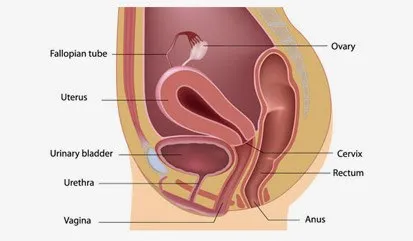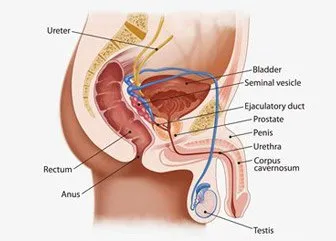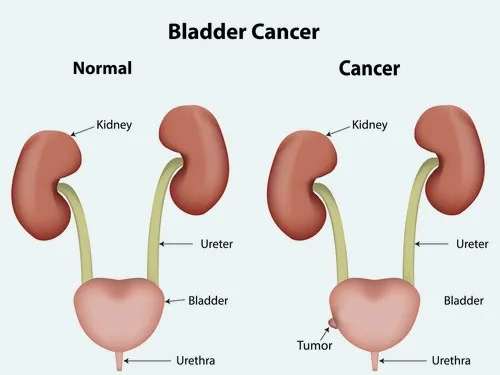Urinary Bladder Function, Location and Pictures in Males and Females
Urinary Bladder Definition:
The urinary bladder function is very important in your body, particularly as one of the excretory organs of the body. Let’s start with urinary bladder definition. Appearing on pelvic floor, it is an important organ of your excretory system that serves as temporary storage point.
The Bladder Image:
As a primary bladder function, it stores the urinary fluid before its elimination through urethra. But how does this body organ look like? You can view its shape and size in the bladder image. Resembling an elastic sac-like structure, the smooth muscle fibers in the wall of the bladder render it great amount of elasticity.

Female Bladder:
With regards to its storage capacity and location, there are slight variations in human males, females and children. For example, the maximum fluid containing volume is comparatively lower in female bladder. In males, it sits between the pubic symphysis and rectum. While female bladder lies anterior to the vagina and inferior to the uterus.
For example, the maximum fluid containing volume is comparatively lower in female bladder. In males, it sits between the pubic symphysis and rectum. While female bladder lies anterior to the vagina and inferior to the uterus.
Your health care provider can diagnose the medical conditions of bladder with the help of cystoscope, x-Ray and urine test and include urinary bladder cancer, inflammation, infection, urinary incontinence, interstitial cystitis, and so on. All these conditions affect the urinary bladder function.
Urinary Bladder Anatomy:
Three tubes open into the lumen or interior of male and female bladder. That is, one comes from the lower side and the other two on the upper side. The two hollow muscular canals that link the bladder with either of the kidneys and convey excretory liquid from the latter to the former are the ureters.
As a part of bladder function, urethra takes urine from the sac and empties it out of the body through urethral opening. Regarding its anatomical structure, the principal layer of bladder wall is made up of the smooth fibers (detrusor muscles). They occur in three arrangements, viz. circular, longitudinal and spiral.
Just at the beginning of the ureters, there is a valve, the ureterovesical junction, that not only prevents reflux of bladder contents, but also ensures the unidirectional flow of urine.
Urinary Bladder Placement:
There is no uniformity of structure, size and location of urinary bladder among humans. That is, it shows variations depending on gender and age of an individual. The age-based difference of its physical dimensions is nothing but a growth-related phenomenon.
The bladder grows larger and larger as the age progresses. However, depending on the amount of its fluid contents, it does shrink and expand in size accordingly. And when empty, it resembles the size and shape of a pear. Let’s have a brief description of the place of the urinary sac in the organization scheme of body structures:
Location of Bladder in Children
Contrary to the general position in the pelvic region among human adults, the bladder has different location in children. That is, it has a bit higher place in abdominal cavity not only in infants, but also in young children. The same is the case even when it is empty and does not contain any traces of urinary excretions.
Location of Bladder in Adult Males
 In this case, the excretory storage organ is comparatively large in size and, consequently, the fluid storage capacity. Concerning its position, the base of this elastic and muscular sac lies in the region between the pubic symphysis and rectum.
In this case, the excretory storage organ is comparatively large in size and, consequently, the fluid storage capacity. Concerning its position, the base of this elastic and muscular sac lies in the region between the pubic symphysis and rectum.
The recto-vesical pouch serves to separate it from the rectum, while the prostate (an exocrine gland of male reproductive system) lies in the region below this urine-storing organ.
Location of Female Bladder
Some aspects of its location are similar in both men and women, but it does manifest certain differences in the opposite genders. In the adult females, the organ lies anterior to the vagina and inferior to the uterus (a structure of female genitals). Owing to the relative shift in location, it also reduces in size as it cannot store as much the volume of urine as in males.
Urinary Bladder Function:
The primary bladder function is to act as a reservoir for the short time storage of excretory fluid received from the kidneys. It also controls the flow of urine with the help of check valves that prevent the unwanted forward or backward flow.
As increasing volume of urine extends the smooth muscle walls, you feel a desire to urinate as soon as possible. Stretching of walls sends signals to the parasympathetic nervous system which generates an appropriate response. It results in the contraction of detrusor muscles to push urine out of the bladder.
To start the process of urination, two regulatory sphincters, present on the way, open simultaneously. One of the sphincters is under your voluntary command, while the other comes under the control of autonomous nervous system.
The normal urine holding capacity of the urinary sac varies from 300 ml to about 350 ml. However, with full dilation, it can hold up to 600 ml of excretory fluid! It means, there is almost twice increase in the volume on the attainment of its full distension.
However, on the collection of 150 ml of fluid, there arises a mild desire to urinate in the individual but they can delay it for a specific duration till the bladder reaches its maximum capacity.
Urinary Bladder Cancer and Other Problems
As an accessory structure, the medical conditions of the organ are actually the disorders of excretory system. The urinary bladder infection can be of various kinds and complexities. They include the urinary bladder cancer and the stones. The bladder stones, for example, may partially or completely block the passage of urine.
Bladder Stones and the Urinary Bladder Pain
 The blockage of urine ultimately leads to acute urinary bladder pain, swelling, injury to the bladder walls and other severe symptoms. Three common treatment measures for the elimination of stones are: drug administration, radiations and surgical therapy. The inflammatory conditions of the urinary sac may arise out of the urinary bladder infections or injuries.
The blockage of urine ultimately leads to acute urinary bladder pain, swelling, injury to the bladder walls and other severe symptoms. Three common treatment measures for the elimination of stones are: drug administration, radiations and surgical therapy. The inflammatory conditions of the urinary sac may arise out of the urinary bladder infections or injuries.
You can cure urinary bladder infection with medications. However, the treatment of urinary bladder cancer requires more advanced and sophisticated methods. The urinary incontinence leaves a tremendous impact on the quality of your life. It involves the involuntary leakage of urine that causes great embarrassment for the victim.
More common in human female than in males, the interstitial cystitis involves the diagnostic symptoms of severe pain and discomfort in the urinary bladder. Furthermore, it triggers urgent & frequent urination.


